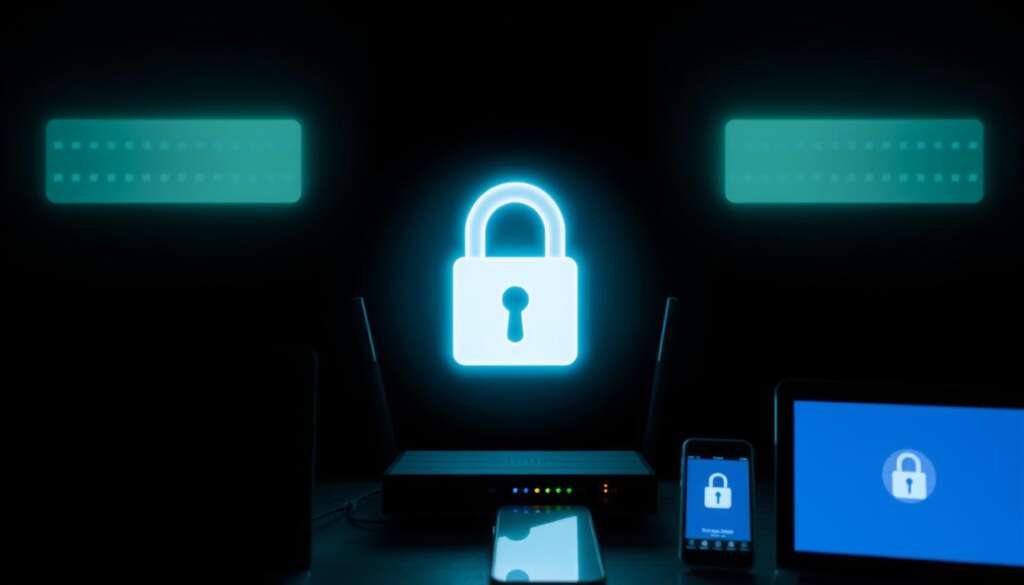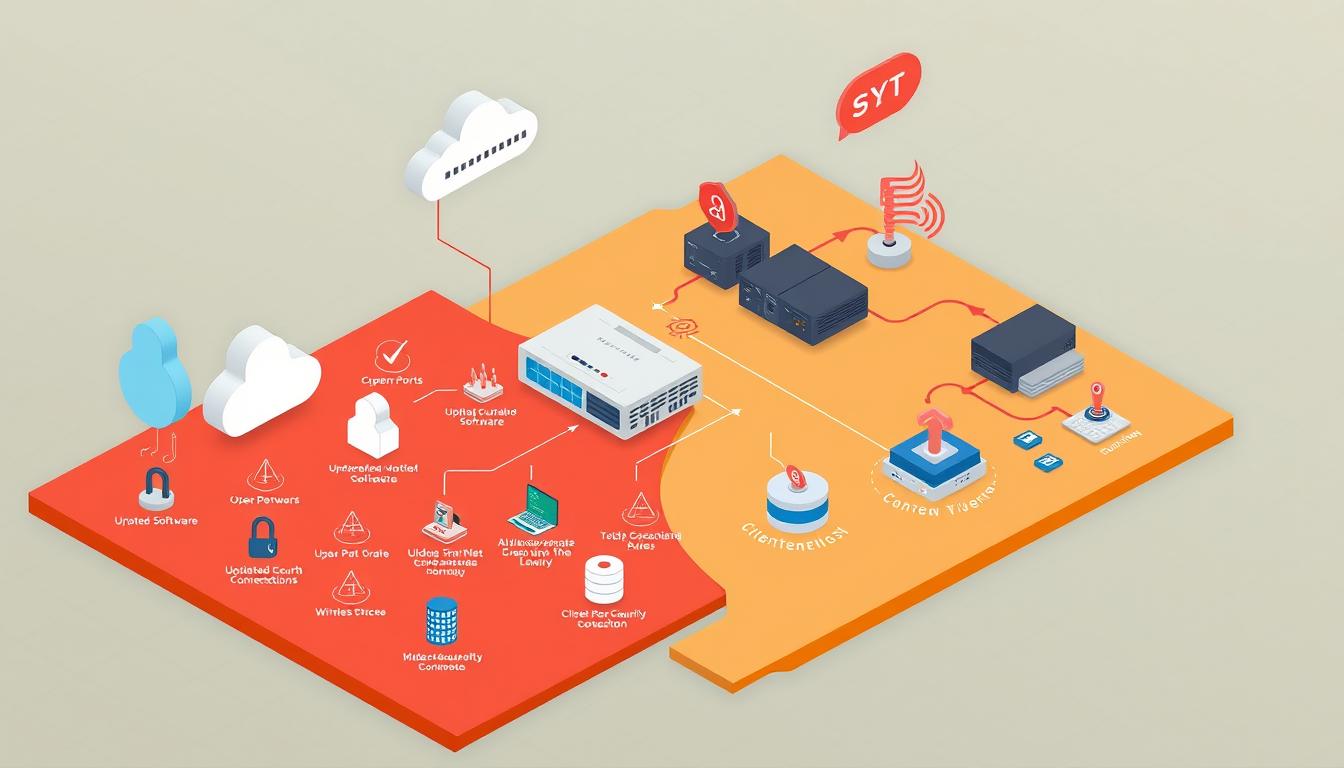In today’s digital world, strong cybersecurity is more important than ever. As we rely more on digital tools, protecting ourselves from cyber threats becomes a top priority. Network vulnerabilities can harm our data and disrupt our work.
By knowing and fixing these weaknesses, we can make our online world safer. This article will explore the common threats to our digital space. We’ll also share ways to fix these problems and keep our networks secure.
Key Takeaways
- Recognizing vulnerabilities is key to better network security.
- Keeping software up to date is essential for safety.
- A strong network needs a variety of security steps.
- Good cybersecurity practices protect both businesses and individuals.
- Knowing common network threats helps us take better security measures.
Understanding Network Vulnerabilities
The digital world keeps getting more complex, and so do cyber threats. It’s vital to know about network vulnerabilities to avoid big cyber-attack repercussions. These are weaknesses in a network that can let attackers in or cause harm.
The Definition of Network Vulnerabilities
Network vulnerabilities are like weak spots in a system. They can be bugs or design flaws that attackers use to get into a network. Knowing about these is key to keeping your network security risks under control in today’s threat landscape.
Types of Network Vulnerabilities
- Software Flaws: Bugs or errors in software that can be manipulated to perform unintended actions.
- Hardware Vulnerabilities: Physical imperfections or design flaws in hardware components that can compromise security.
- Configuration Errors: Poorly configured network devices that leave open doors for attackers, such as default passwords and open ports.
- Outdated Systems: Systems that have not been updated or patched to defend against the latest threats pose significant risks.
Impact on Businesses and Individuals
The effects of network vulnerabilities can be huge. They can cause financial losses, theft of important data, damage to a brand’s reputation, and loss of customer trust. In today’s world, the indirect effects, like fines and legal costs, can make things even worse.
Understanding and fixing network vulnerabilities is more than just protecting data. It’s about keeping an organization safe in a world full of network security risks.
Weak Credentials: The Front Door for Hackers
In today’s digital world, weak passwords are a big risk. Simple or reused passwords make it easy for hackers to get in. This puts both password security and account protection at risk. It’s important to understand how these weaknesses lead to breaches to improve security.
How Weak Credentials Lead to Breaches
Many cyber attacks start with weak passwords. Hackers use tools to guess or find leaked passwords. Once they get in, they can steal data, causing big problems for people and companies.
Strategies for Strengthening Credentials
- Enforce password complexity: Mandate a mix of uppercase, lowercase, numbers, and special characters.
- Implement regular password updates: Establish policies requiring users to change passwords at regular intervals.
- Encourage the use of passphrase: Suggest crafting passwords from a random set of words, making them easier to remember but hard to guess.
Implementing Multi-Factor Authentication (MFA)
Multi-factor authentication adds extra security by needing more than one way to log in. This could be a password, a device, or biometric data. MFA makes it harder for hackers to get in, protecting accounts better.
Knowing the dangers of weak passwords and using strong authentication helps a lot. These steps not only make accounts safer but also protect the whole network from threats.
Software Vulnerabilities: The Need for Regular Patching
In the world of cybersecurity, tackling software vulnerabilities is key. Regular patching is a simple yet vital step to boost network security. It helps stop possible exploits.
Many groups don’t see the importance of regular security updates. These updates are more than just fixes; they’re vital defenses against threats. Each update aims to block specific vulnerabilities that hackers could use to get in or disrupt things.
Actively finding and managing software vulnerabilities can really cut down on cyber attack risks. Let’s look at how companies can handle these vulnerabilities well:
Identifying Vulnerable Software
Finding vulnerable software in an organization’s digital setup is the first step. This involves using advanced security tools to scan systems. These tools find outdated software or known vulnerabilities. Quick action is important to stop threats before they happen.
The Role of Patching Systems in Security
Having a strong patch management system is vital for keeping IT systems safe. Regular patches fix security holes and make systems better at fighting off cyber attacks. By focusing on and automating security updates, companies keep their systems safe and meet industry standards.
Success in managing vulnerabilities depends on a company’s dedication to security. This includes regular updates and being proactive in preventing exploits. This ongoing effort protects valuable data and keeps trust in a changing threat world.
Misconfigured Routers and Firewall Gaps
Misconfigurations in routers and firewalls are big security risks. They can let cyber threats in and harm your network’s safety. It’s important to know common mistakes and manage devices securely to protect your network.
Common Configuration Mistakes
Many router and firewall mistakes come from simple errors or not knowing how to secure them. Default settings often lack security, making networks vulnerable. Also, weak passwords and unsecured management interfaces add to the danger.
Securing Network Devices Through Proper Configuration
Managing devices well is key to keeping your network safe. Setting up secure settings on devices blocks unauthorized access and helps your network bounce back from attacks. This means keeping devices updated and controlling how they’re set up.
| Issue | Risk | Preventative Measure |
|---|---|---|
| Default Settings | Easy access for attackers | Custom configurations and strong passwords |
| Insecure Interfaces | Network breaches | Firewalling and secure protocols |
| Outdated Firmware | Vulnerabilities to exploits | Regular updates and patches |
Network Vulnerabilities
In today’s world, it’s key to understand and fix network vulnerabilities. This keeps information systems safe and private. A good plan includes network security assessment, vulnerability scanning, and risk analysis. These steps help find threats and protect networks.
How to Identify Network Vulnerabilities
First, you need a detailed network security check. This looks for security risks and weaknesses. It checks network setups, scans for vulnerabilities, and does risk analysis to see how bad these issues could be.
Tools for Network Vulnerability Assessment
Many tools are important for scanning and checking networks. They make scanning easier and give detailed reports. These reports show where the network is most at risk. Here are some main tools for network checks:
- Vulnerability Scanners: These tools scan for known security problems.
- Configuration Management Tools: They make sure systems are set up securely and follow best practices.
- Network Security Monitoring Tools: These tools watch network traffic and logs for signs of trouble.
Using these tools, companies can better find and fix security risks. This makes their networks stronger against cyber threats.
Phishing Attacks and Social Engineering
In today’s digital world, it’s key to boost cyber awareness and build strong social engineering defenses. Phishing attacks are common, using tricks to get people to share private info. We’ll explore phishing and how to train staff to spot and handle these threats.
Understanding Phishing Tactics
Phishing uses fake emails and websites to look real. It’s not just about stealing data; it’s about getting into networks or installing malware. Knowing the signs of phishing, like urgent messages or links from unknown sites, is vital.
Training Employees to Recognize Phishing Attempts
Starting social engineering defenses means training everyone. Teach staff to check emails for warning signs, doubt unexpected requests, and verify identities securely. Training and simulated phishing tests help make email security a priority and teach staff to act fast when threats arise.
Port Scanning and Its Implications for Network Security
Port scanning is a key tool for security checks but is often not well understood. It helps protect networks but can also be used by hackers to harm them.
It’s important to know the difference between good and bad port scanning. This knowledge helps security experts set up strong firewall configurations and intrusion detection systems. These tools help keep networks safe from unauthorized access.
Spotting malicious port scanning means watching for unusual traffic or scan patterns. These could be signs of hackers trying to gather information. Teaching people to recognize these signs is vital for protecting networks.
Setting up strong firewall configurations is another way to block unwanted scans. Firewalls need to be set up right to let in good traffic while keeping out bad. This requires knowing the network’s layout and typical traffic patterns.
| Feature | Benefit |
|---|---|
| Advanced Intrusion Detection | Monitors network for suspicious activities, enhances security alerts and response times. |
| Dynamic Firewall Configuration | Adapts to new security threats automatically, reduces risk of unauthorized access. |
Improving network security against port scanning threats requires ongoing effort. This includes keeping security systems up to date with the latest intrusion detection protocols and firewall settings. By staying informed and ready, organizations can protect their important assets from cyber threats.
Unsecured Wi-Fi Networks: An Easy Target for Cybercriminals
In today’s world, keeping your Wi-Fi safe is a must. Cybercriminals look for weak spots, and unsecured networks are an easy target. That’s why using Wi-Fi encryption and secure access points is key to protecting your data.
Why is Wi-Fi Security so important? Without strong security, Wi-Fi networks face many threats. These include eavesdropping, unauthorized access, and misuse of network resources. This puts your personal and work data at risk and opens you up to cyber-attacks.
What can be done to improve wireless network security? The main steps are to enable Wi-Fi encryption, secure access points, and watch for intruders.

- Enable Wi-Fi Encryption: Use advanced encryption like WPA3 to keep data safe from interception.
- Secure Access Points: Change default usernames and passwords, disable WPS, and hide your network SSID to block unauthorized access.
- Implement Network Monitoring: Keep an eye on network traffic to spot security breaches early and act fast.
By taking these steps, you can make your Wi-Fi network much safer. This ensures a secure internet experience for everyone.
Conclusion
In today’s world, keeping your digital stuff safe is a must, not just a good idea. We’ve looked at common threats and why staying safe online is key. To start, make sure all passwords are strong and use Multi-Factor Authentication to add extra security.
Also, keep your software up to date and watch out for mistakes in your network setup. Teaching your team to spot and stop phishing attacks is also vital. And, make sure your Wi-Fi is secure to avoid wireless threats.
To keep your network safe, put these steps into a solid security plan. Regular updates, strong passwords, and well-configured devices are important. Educating your team and staying alert to new threats will make your network even stronger. Always be ready to defend your digital world.


